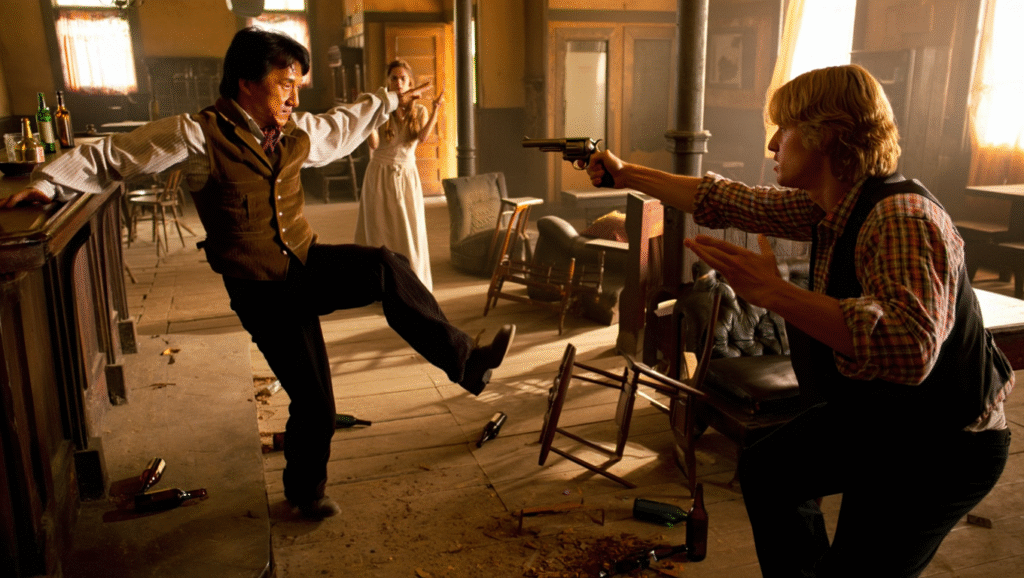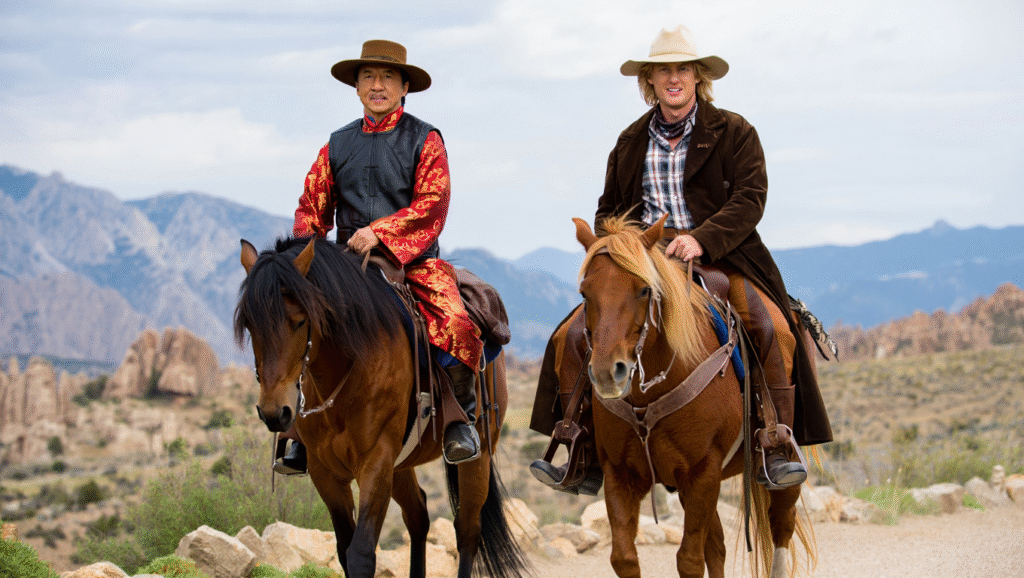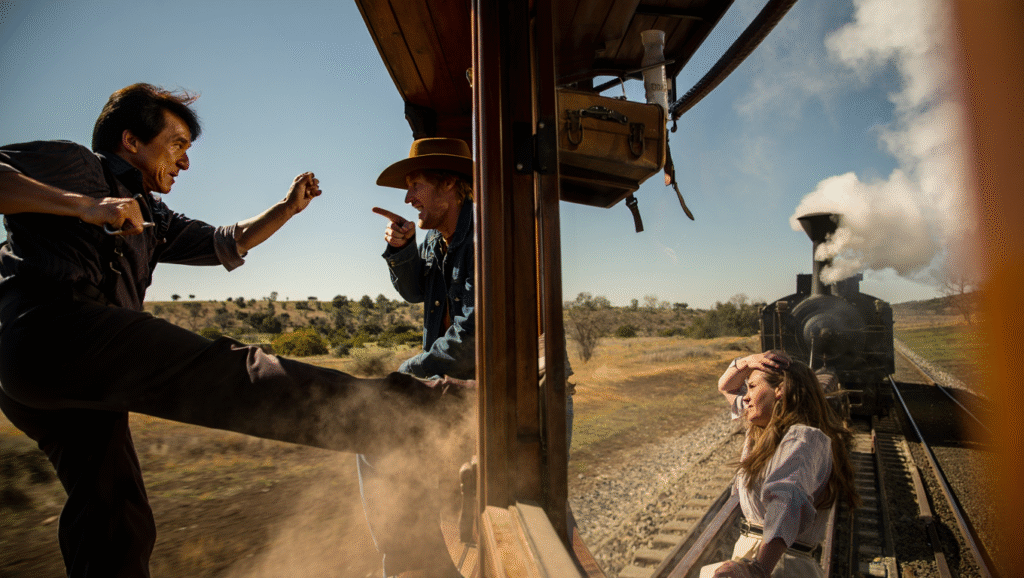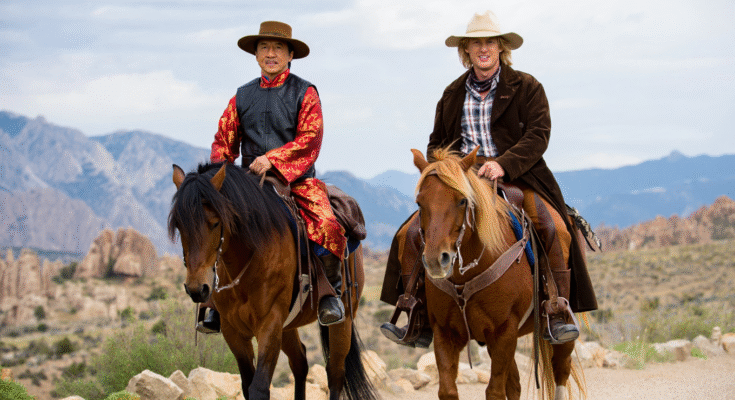When Jackie Chan and Owen Wilson first teamed up in Shanghai Noon (2000), audiences were treated to a rare blend of martial arts mayhem and cowboy charm. Its sequel, Shanghai Knights (2003), carried the unlikely duo across the Atlantic for another round of mismatched chaos. Now, over two decades later, Shanghai Noon 3 gallops onto the scene, promising not just nostalgia, but a wild, globe-spanning ride that reminds us why Chan and Wilson remain one of comedy-action’s most irresistible pairings.

The film’s setup wastes no time: Chon Wang (Chan), now a weary but ever-honorable hero, finds himself pulled back into Roy O’Bannon’s (Wilson) schemes—this time on a scale neither could have imagined. Their journey moves beyond dusty saloons and train robberies, expanding into international intrigue that spans deserts, city skylines, and even rooftops where Chan can once again defy gravity with his signature stunts.
Jackie Chan, at 71, hasn’t lost his gift for blending humor with high-octane physicality. His stunts may be more measured, but they carry the same inventive charm: a barroom fight where every chair, bottle, and ceiling fan becomes a weapon; a rooftop chase that turns into a dance of desperation and wit. Chan reminds us that action is not just about impact—it’s about rhythm, timing, and storytelling.

Owen Wilson slips back into Roy O’Bannon like no time has passed. His dry, self-deprecating wit is the perfect foil to Chan’s earnest determination. Wilson plays Roy as both coward and loyal friend, a conman who fumbles into bravery when it matters most. Their chemistry remains the franchise’s heartbeat, each joke landing because it springs from their mismatched yet inseparable bond.
Enter Nia Long, whose presence elevates the dynamic. As a quick-witted strategist with her own motives, she injects new energy into the duo’s rhythm, at times clashing with Roy’s swagger and at other times holding her own against Chon’s martial arts precision. She is no sidekick; instead, she’s a catalyst who tests loyalties and forces the men to confront what their partnership truly means.
The action set pieces expand in scope, but they remain grounded in the scrappy inventiveness that defined the earlier films. Fuqua-esque shootouts this is not—Shanghai Noon 3 embraces slapstick chaos where timing is everything. A saloon brawl might spiral into an accidental symphony of broken furniture, while an international heist sequence could collapse into chaos thanks to Roy’s hapless greed.

But amid the laughter and spectacle, there’s an undercurrent of reflection. The film acknowledges the passage of time—not just for the characters, but for Chan and Wilson themselves. Their banter is laced with subtle nods to aging, missed opportunities, and the unshakable pull of adventure. This makes their antics feel earned rather than recycled, a victory lap that carries weight.
Directorly choices lean heavily on practical effects and stunt choreography, resisting the urge to drown the film in CGI excess. It’s a wise decision—fans came for Jackie Chan’s physical artistry, and the film delivers with creative set design and sharp editing that highlights movement rather than obscuring it. The result feels both modern and timeless, a tribute to the roots of action-comedy.
Comedy, of course, is where Shanghai Noon 3 shines brightest. Wilson’s deadpan delivery collides hilariously with Chan’s physical humor, producing moments that feel improvised, chaotic, and wholly genuine. Whether it’s Roy mangling cultural customs or Chon trying (and failing) to keep things dignified, the laughs flow naturally from character rather than forced punchlines.

As the climax unfolds, the stakes grow personal. Old villains resurface, new betrayals sting, and the central question emerges: can Chon and Roy trust each other one last time when everything is on the line? The final showdown is equal parts heartfelt and hilarious, delivering the kind of payoff that only a twenty-five-year partnership could earn.
In the end, Shanghai Noon 3 isn’t just a sequel—it’s a celebration. A celebration of martial arts ingenuity, of buddy-comedy brilliance, and of two actors whose chemistry has aged like fine whiskey. It may not reinvent the genre, but it doesn’t need to. At an anticipated 8.1/10, this third ride is a joyous reminder that sometimes the best stories aren’t about winning gold or glory—they’re about riding into chaos with your best friend by your side.



